By Ken Lain, the mountain gardener
Bearded Irises are tall, elegant additions to a flower border but quickly can crowd and 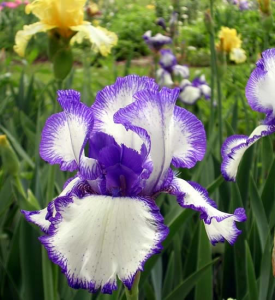 choke themselves in their garden space. You can keep them blooming through regular division of the rhizomes, or roots, every 2-3 years. If left undivided, the flowers become small, decrease in blooming numbers, and become susceptible to pests and disease. If your iris bed is over three years old, your garden will benefit from this column’s information.
choke themselves in their garden space. You can keep them blooming through regular division of the rhizomes, or roots, every 2-3 years. If left undivided, the flowers become small, decrease in blooming numbers, and become susceptible to pests and disease. If your iris bed is over three years old, your garden will benefit from this column’s information.
Divide bearded irises anytime after flowering, through the month of October. Using a pitchfork, carefully dig around the iris bed, starting about a foot away from the outermost edge. Try not to pierce rhizomes with the fork. Gently lift the rhizomes out of the soil. Since bearded iris are grown at soil level, this is one of the easiest plants to lift.
Rinse off soil clinging to rhizomes – Once you have the iris rhizomes out of the ground, shake off any loose soil. Now rinse any remaining soil with a garden hose. If 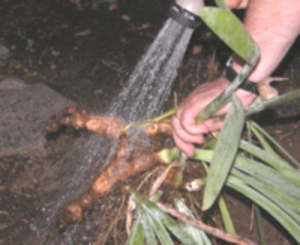 you don’t have space to do this in the garden, it is sometimes easier and neater to do it over a tarp. Rinsing off the soil allows you to better see the rhizomes to inspect them for damage.
you don’t have space to do this in the garden, it is sometimes easier and neater to do it over a tarp. Rinsing off the soil allows you to better see the rhizomes to inspect them for damage.
Once the rhizomes are cleaned, you can separate the individual rhizomes from one another. Don’t break them apart just yet; only loosen the naturally delineated sections.
Cut back the leaves to 6” lengths. Once the rhizomes or roots are clean, cut the  foliage to 6 inch lengths. Cutting the fan of leaves connected to a lifted iris rhizome makes the plant easier to work with when dividing and replanting, and helps prevent water loss while the plant becomes re-established. The fan does not need to be cut symmetrically. Some leaves may be damaged and will need to be cut shorter than 6 inches. The leaves will start to grow back, with the middle leaf growing tallest.
foliage to 6 inch lengths. Cutting the fan of leaves connected to a lifted iris rhizome makes the plant easier to work with when dividing and replanting, and helps prevent water loss while the plant becomes re-established. The fan does not need to be cut symmetrically. Some leaves may be damaged and will need to be cut shorter than 6 inches. The leaves will start to grow back, with the middle leaf growing tallest.
Inspect roots for borer damage and soft rot. Once the roots are clean, inspect them for small to medium holes. These are signs of borer damage. If your iris leaves have 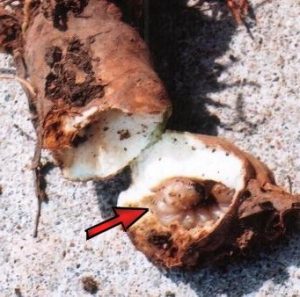 dark streaks through them, you probably have iris borers. Also look for soft spongy spots. These indicate another common iris problem called soft rot.
dark streaks through them, you probably have iris borers. Also look for soft spongy spots. These indicate another common iris problem called soft rot.
Using a sharp knife or pruners remove any trace of either iris borer damage or soft rot and dispose of these segments. Soft rot spreads easily, so disinfect your cutting tool with denatured alcohol between cuts to prevent spreading contamination.
Dividing Healthy Rhizomes – Now you are ready to divide the remaining healthy 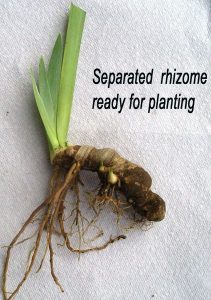 rhizomes. You will see natural places to make a split, such as where the rhizome has forked. Study to make sure each section you’ve chosen will wind up being at least 3 inches long and have healthy roots growing from it. Now, Be Bold! Go ahead and make a clean cut through the rhizome, using the same sharp, disinfected knife or pruner.
rhizomes. You will see natural places to make a split, such as where the rhizome has forked. Study to make sure each section you’ve chosen will wind up being at least 3 inches long and have healthy roots growing from it. Now, Be Bold! Go ahead and make a clean cut through the rhizome, using the same sharp, disinfected knife or pruner.
Preparing the new iris bed – The final step is re-planting your divided irises. Choose a full sun location and start by re-amending your plot’s soil.
Mulch, Soil Activator, 7-4-4 Food – Prepare the new bed by spreading a 2-3” inch layer of Watters “Mulch” then add “Soil Activator” and Watters 7-4-4 “All Purpose Plant Food” at the recommended rates. Mulch keeps soil loose so roots spread quickly. Soil Activator stimulates new Irises to form deeper roots. Watters All Purpose Plant Food feeds the plants for maximum flower size with brighter colors. Blend these amendments into the soil to one shovel’s depth and then rake the surface smooth.
The garden is now ready for planting. Only 2-4 inches of soil should cover each root. If planted too deep, flowers will be small or completely absent. Keep the iris bed looking 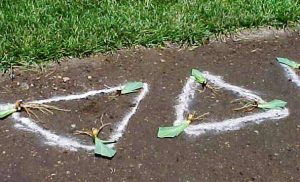 natural by replanting roots in triangular formations.
natural by replanting roots in triangular formations.
Water thoroughly using Watters “Root & Grow”. This liquid root stimulator encourages strong new root hairs to form, and starts the growing process of next spring’s plants. Use “Root & Grow” every 2 weeks for the first 3 months to maximize roots and blooms.
When finished, you’ve done the work necessary to guarantee another couple of years of beautiful, carefree, iris blooms.
Until next week, I’ll see you at the garden center.
Ken Lain can be found throughout the week at Watters Garden Center, 1815 W. Iron Springs Rd in Prescott, or contacted through his web site at WattersGardenCenter.com or FB.com/WattersGardenCenter .

